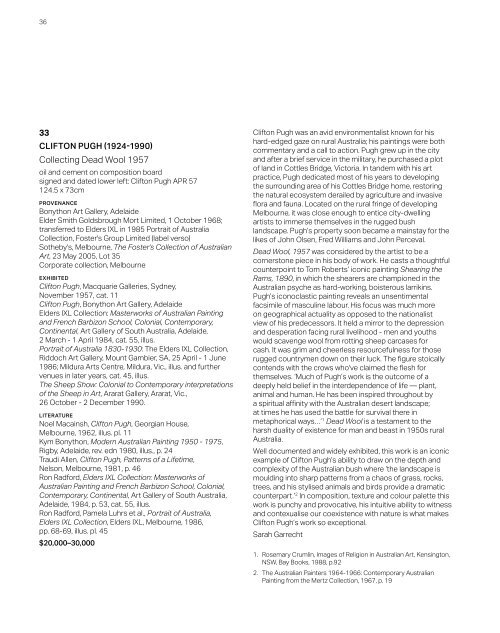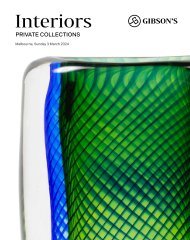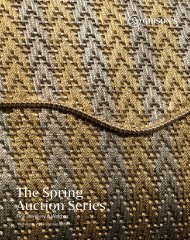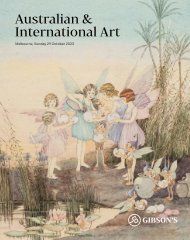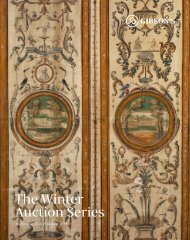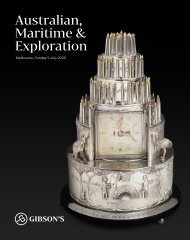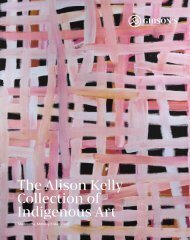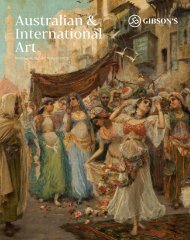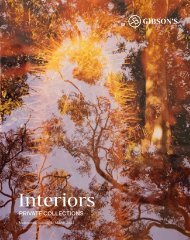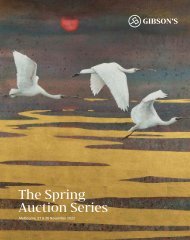GA039 | Australian & International Art
Create successful ePaper yourself
Turn your PDF publications into a flip-book with our unique Google optimized e-Paper software.
36<br />
33<br />
CLIFTON PUGH (1924-1990)<br />
Collecting Dead Wool 1957<br />
oil and cement on composition board<br />
signed and dated lower left: Clifton Pugh APR 57<br />
124.5 x 73cm<br />
PROVENANCE<br />
Bonython <strong>Art</strong> Gallery, Adelaide<br />
Elder Smith Goldsbrough Mort Limited, 1 October 1968;<br />
transferred to Elders IXL in 1985 Portrait of Australia<br />
Collection, Foster's Group Limited (label verso)<br />
Sotheby's, Melbourne, The Foster's Collection of <strong>Australian</strong><br />
<strong>Art</strong>, 23 May 2005, Lot 35<br />
Corporate collection, Melbourne<br />
EXHIBITED<br />
Clifton Pugh, Macquarie Galleries, Sydney,<br />
November 1957, cat. 11<br />
Clifton Pugh, Bonython <strong>Art</strong> Gallery, Adelaide<br />
Elders IXL Collection: Masterworks of <strong>Australian</strong> Painting<br />
and French Barbizon School, Colonial, Contemporary,<br />
Continental, <strong>Art</strong> Gallery of South Australia, Adelaide,<br />
2 March - 1 April 1984, cat. 55, illus.<br />
Portrait of Australia 1830-1930: The Elders IXL Collection,<br />
Riddoch <strong>Art</strong> Gallery, Mount Gambier, SA, 25 April - 1 June<br />
1986; Mildura <strong>Art</strong>s Centre, Mildura, Vic., illus. and further<br />
venues in later years, cat. 45, illus.<br />
The Sheep Show: Colonial to Contemporary interpretations<br />
of the Sheep in <strong>Art</strong>, Ararat Gallery, Ararat, Vic.,<br />
26 October - 2 December 1990.<br />
LITERATURE<br />
Noel Macainsh, Clifton Pugh, Georgian House,<br />
Melbourne, 1962, illus. pl. 11<br />
Kym Bonython, Modern <strong>Australian</strong> Painting 1950 - 1975,<br />
Rigby, Adelaide, rev. edn 1980, illus., p. 24<br />
Traudi Allen, Clifton Pugh, Patterns of a Lifetime,<br />
Nelson, Melbourne, 1981, p. 46<br />
Ron Radford, Elders IXL Collection: Masterworks of<br />
<strong>Australian</strong> Painting and French Barbizon School, Colonial,<br />
Contemporary, Continental, <strong>Art</strong> Gallery of South Australia,<br />
Adelaide, 1984, p. 53, cat. 55, illus.<br />
Ron Radford, Pamela Luhrs et al., Portrait of Australia,<br />
Elders IXL Collection, Elders IXL, Melbourne, 1986,<br />
pp. 68-69, illus. pl. 45<br />
$20,000–30,000<br />
Clifton Pugh was an avid environmentalist known for his<br />
hard-edged gaze on rural Australia; his paintings were both<br />
commentary and a call to action. Pugh grew up in the city<br />
and after a brief service in the military, he purchased a plot<br />
of land in Cottles Bridge, Victoria. In tandem with his art<br />
practice, Pugh dedicated most of his years to developing<br />
the surrounding area of his Cottles Bridge home, restoring<br />
the natural ecosystem derailed by agriculture and invasive<br />
flora and fauna. Located on the rural fringe of developing<br />
Melbourne, it was close enough to entice city-dwelling<br />
artists to immerse themselves in the rugged bush<br />
landscape. Pugh’s property soon became a mainstay for the<br />
likes of John Olsen, Fred Williams and John Perceval.<br />
Dead Wool, 1957 was considered by the artist to be a<br />
cornerstone piece in his body of work. He casts a thoughtful<br />
counterpoint to Tom Roberts’ iconic painting Shearing the<br />
Rams, 1890, in which the shearers are championed in the<br />
<strong>Australian</strong> psyche as hard-working, boisterous larrikins.<br />
Pugh’s iconoclastic painting reveals an unsentimental<br />
facsimile of masculine labour. His focus was much more<br />
on geographical actuality as opposed to the nationalist<br />
view of his predecessors. It held a mirror to the depression<br />
and desperation facing rural livelihood - men and youths<br />
would scavenge wool from rotting sheep carcases for<br />
cash. It was grim and cheerless resourcefulness for those<br />
rugged countrymen down on their luck. The figure stoically<br />
contends with the crows who've claimed the flesh for<br />
themselves. ‘Much of Pugh’s work is the outcome of a<br />
deeply held belief in the interdependence of life — plant,<br />
animal and human. He has been inspired throughout by<br />
a spiritual affinity with the <strong>Australian</strong> desert landscape;<br />
at times he has used the battle for survival there in<br />
metaphorical ways…’ 1 Dead Wool is a testament to the<br />
harsh duality of existence for man and beast in 1950s rural<br />
Australia.<br />
Well documented and widely exhibited, this work is an iconic<br />
example of Clifton Pugh’s ability to draw on the depth and<br />
complexity of the <strong>Australian</strong> bush where ‘the landscape is<br />
moulding into sharp patterns from a chaos of grass, rocks,<br />
trees, and his stylised animals and birds provide a dramatic<br />
counterpart.’ 2 In composition, texture and colour palette this<br />
work is punchy and provocative, his intuitive ability to witness<br />
and contexualise our coexistence with nature is what makes<br />
Clifton Pugh’s work so exceptional.<br />
Sarah Garrecht<br />
1. Rosemary Crumlin, Images of Religion in <strong>Australian</strong> <strong>Art</strong>, Kensington,<br />
NSW, Bay Books, 1988, p.92<br />
2. The <strong>Australian</strong> Painters 1964-1966: Contemporary <strong>Australian</strong><br />
Painting from the Mertz Collection, 1967, p. 19


